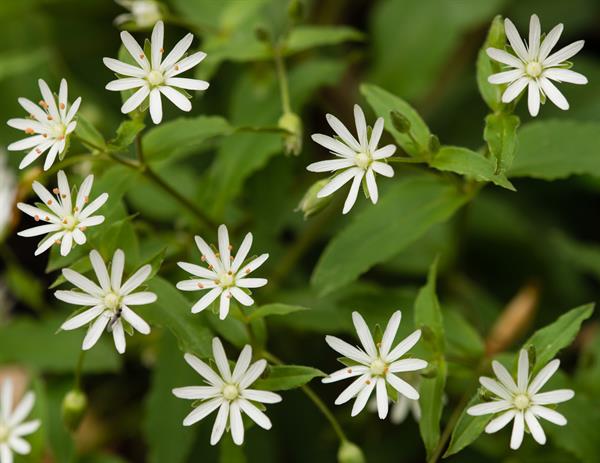
ID notes:Both Stellaria corei and Stellaria pubera have an interesting seasonal growth form, producing short and relatively small-leaved flowering shoots in the spring (which wither following fruiting), followed by taller, more vigorous summer shoots with larger and tougher leaves and lacking flowers, which persist until autumn. Some of the description in various manuals of differences in petiole length and leaf size and shape between the two species is obscured or complicated by these seasonal differences; more careful observation is needed.
Origin/Endemic status: Native
Synonymy: = FNA5, G, Il, K1, K3, K4, NY, Pa, RAB, Tat, Tn, Va, W, WH3, WV; = Alsine pubera (Michx.) Britton – S, S13; = Stellaria puber Michx. – Fl4, K4; = Stellaria pubera Michx. var. pubera – C, F
Heliophily: 3
Hover over a shape, letter, icon, or arrow on the map for definition or see the legend.
 © Keith Bradley | Original Image ⭷
© Keith Bradley | Original Image ⭷ © Richard & Teresa Ware CC-BY-NC, permission granted to NCBG | Original Image ⭷
© Richard & Teresa Ware CC-BY-NC, permission granted to NCBG | Original Image ⭷ © Joey Shaw source | Original Image ⭷
© Joey Shaw source | Original Image ⭷ © Richard & Teresa Ware CC-BY-NC, permission granted to NCBG | Original Image ⭷
© Richard & Teresa Ware CC-BY-NC, permission granted to NCBG | Original Image ⭷ © Joey Shaw source | Original Image ⭷
© Joey Shaw source | Original Image ⭷ © Edwin Bridges | Original Image ⭷
© Edwin Bridges | Original Image ⭷ © Joey Shaw source | Original Image ⭷
© Joey Shaw source | Original Image ⭷ © Bruce A. Sorrie | Original Image ⭷
© Bruce A. Sorrie | Original Image ⭷Feedback
See something wrong or missing on about Stellaria pubera? Let us know here: (Please include your name and email if at all complicated so we can clarify if needed.)
Cite as...